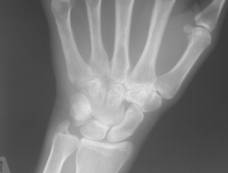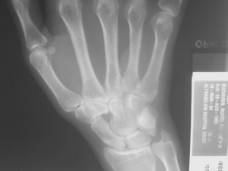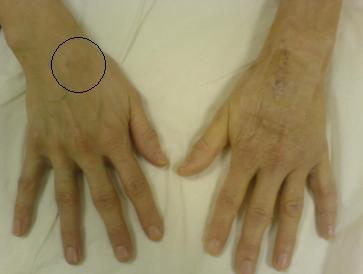|
Omar
Mohamed*, Martyn Neil**
* Senior House Officer
**Specialist Registrar
Department of Orthopaedics, Altnagelvin Hospital, N.
Ireland
Address for Correspondence:
Mr. O. Mohamed
Department of Orthopaedics
Level 9, Altnagelvin Hospital, Glenshane Rd., Londonderry, BT47
6SB,
N. Ireland.
E-mail: omar_mohamed7@hotmail.com
Tel : +447795594077
|
|
Abstract:
We report the case of a 36 year old
female with bilateral painful carpal bossing with underlying
bilateral capitate-hamate coalitions.
Unilateral debulking surgery involved removal of ECRL at
its tendinous insertion. This
resulted in significant relief of her pain.
Our experience highlights a likely association between
carpal coalitions and the ‘congenital’ carpal boss.
It also strengthens the hypothesis that painful bossing
is secondary to repetitive strain injury at ECRL/B tendon
insertions, and where indicated, ECRL insertion detachment may
afford significant relief of symptoms.
Keywords:
Carpal coalition; ECRL; Boss
J.Orthopaedics 2007;4(2)e31
Case Report:
A 36 year old
female presented with bilateral symptomatic carpal bossing and
radiographs revealed bilateral capitate-hamate coalitions.
The bossing had been present since childhood but lately
would ache with strenuous use of her hands.
Previous surgery to debulk the boss in each hand was
unsuccessful. At
re-operation on her left hand, debulking involved ECRL tendon
attachment which was inserting into the boss.
It was re-attached at the end of the procedure to nearby
soft tissue with absorbable suture.
At follow-up
after 3 months, the patient’s symptoms had significantly
improved in that hand. She
is awaiting a repeat procedure on the other hand.
Discussion :
Carpal bossing
is a bony prominence over the dorsum of the wrist, typically
over the 2nd and 3rd metacarpal bases1. It is not an
uncommon condition for which surgical intervention is not always
successful2. Most patients present with new onset of
swelling on the dorsum of the wrist which may or may not be
symptomatic. In a group of patients the swelling appears
to be congenital. The aetiology of carpal bossing is yet
unclear, with various theories put forward. These include
rupture of the dorsal ligament due to trauma or repetitive
strain, congenital predisposition, symptomatic os styloideum
with secondary osteoarthritic degeneration and traumatic
periostitis3. The mechanism is likely however to be
different for the ‘congenital’ and ‘acquired’ groups.
In those patients with an absence of degenerative wrist changes,
a repetitive traction injury at the insertions of ECRB/L is
likely the cause of associated pain, and may also explain the
onset of the prominence in the ‘acquired’ boss. While
this may also explain the onset of pain in a ‘congenital’
boss, it is a less suitable explanation for the origin of such a
boss.
|
 |
 |
|
Figure 1 Bilateral
capitate-hamate coalitions
|
|

|
|
Figure 2 Post-operative
picture – carpal boss on Right hand circled.
|
Carpal
coalitions are rare in Caucasian races and are usually
asymptomatic4. Capitate-hamate coalitions are the second
commonest variety5. Carpal coalitions can co-exist with
carpal bossing; the altered biomechanics of the wrist are one
suggested cause6. A previous cadaveric anatomic study has
suggested a possible association between carpal coalition and
dorsal carpal bossing1. Our case appears to be the first
case of bilateral carpal bossing with associated capitate-hamate
coalitions. Our experience has highlighted three important
points. Firstly, that repetitive traction injury at the
ECRB/L insertions is the most likely explanation for the onset
of symptoms with carpal bossing (in the absence of degenerative
wrist changes). Secondly, that although no previous strong
association has been reported between carpal coalitions and
carpal bossing, our case supports the theory that the
‘congenital’ carpal boss is in fact a congenital carpal
coalition1. The alteration in wrist biomechanics inherent
in such a large carpal coalition would then predispose the
patient to developing repetitive strain injury and pain at a
tendinous insertion. It is feasible that patients with
normal wrists, who ‘acquire’ a carpal boss, may have
symptoms secondary to higher physical repetitive loads such as
from their occupation. Thirdly, it is interesting to note
that our patient only improved with debulking surgery that
involved removal of the ECRL tendon insertion. It may be
argued that given the typical site of carpal bossing, debulking
surgery should be performed with the aim of removing the ECRL
tendinous insertion if it is located in the boss – a
definitive end-point. ECRB, the more ulnar of the two
tendons, is the prime wrist extensor and thus should be
preserved. Cuono and Watson7 recommend a procedure
involving excavation of a cavity at the carpometacarpal joint,
primarily indicated in the degenerative wrist, with an ECRB/L-sparing
approach. Our procedure was more conservative in terms of
bone removal, and in patients with minimal arthritic change, may
be an acceptable alternative.
Conclusion:
Bilateral carpal bossing with bilateral
underlying capitate-hamate coalitions has not previously been
reported. No previous association has been documented
between the two, our case highlighting the likely aetiology of a
subgroup of patients with ‘congenital bossing’. A
different surgical approach not discussed previously in the
literature was undertaken. This involved debulking of the
boss and removal of ECRL tendon inserting into it. Our
experience strengthens the hypothesis that repetitive traction
injury is the likely cause of painful carpal bossing in patients
with minimal carpal degenerative change. These patients
are also predisposed to developing osteoarthritis of the wrist
joints7, this being a separate cause of wrist pain which
requires different surgical intervention. (799 Words)
Reference :
- Nakamura K,
Patterson RM, Viegas SF. The
Ligament and Skeletal Anatomy of the Second Through Fifth
Carpometacarpal Joints and Adjacent Structures. The Journal of Hand Surgery 2001; 26A(6): 1016-1029
- Clarke AM, Wheen DJ, Visvanathan S, Herbert TJ, Conolly WB. The Symptomatic Carpal Boss: Is Simple Excision Enough? Journal of Hand Surgery (Br) 1999; 24B(5): 591-595
- Van Der Aa
JPW, Noorda RJP, van Royen BJ. Symptomatic Carpal Boss. Orthopedics 1999; 22 (7):
703-704
- Simmons BP,
McKenzie WD. Symptomatic
Carpal Coalition. The
Journal of Hand Surgery 1985; 10A (2): 190-193
- Singh P, Tuli
A, Choudhry R, Mangal A. Intercarpal
Fusion – A Review. Journal
of The Anatomical Society of India 2003; 52(2): 183-188
- Geutjens G. Carpal Bossing with Capitate-Trapezoid Fusion. Acta Orthopaedica Scandinavica 1994; 65(1): 97-98
- Fusi S,
Watson HK, Cuono CB. The
Carpal Boss: A 20-year review of operative management. Journal of Hand Surgery (Br) 1995; 20B(3): 405-408
|





